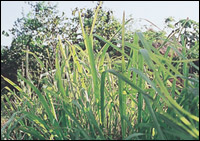


 Lemon Grass
Lemon GrassAlthough a fairly new addition to the Oriental repertoire of herbs, lemon grass is a major flavouring agent in cooking. |
|
The Thais and Vietnamese swear by its diuretic effect and refreshing flavour. And Indian chefs and gourmets have realised that a few strands of this unusual grass is enough to bring a zing to most recipes. Lemon grass also adds a subtle and exotic flavour to tea, and had in the afternoon, post-lunch, a cuppa lemon grass tea is said to be most refreshing. Lemon grass grows wild in hot climates where there is an abundance of sunshine and rain. That�s why it is most commonly found in the tropics. This herb is a perennial, aromatic, tall grass with a thick stalk and tufty roots. Its taste is vibrant and is characterised by a strong citrus flavour. Fresh stalks of lemon grass and its leaves have a clean, lemon-like odour. The grass itself is pale green-yellow in colour and has narrow leaves with sharp edges. It grows in clusters and is about three feet long. Vegetable vendors cut the long blades of grass to manageable sizes, sometimes dry them, or sell them fresh and cheap. Fresh lemon grass stalks can be stored in the refrigerator for up to a week. The straw-like tops of the lemon grass should be trimmed and the stalks should be thinly sliced before use. While buying, tear of a tiny piece of the leaf and check the aroma. The leaf also contains an essential sherry-coloured oil, which is used in perfumery. When added to food, lemon grass brings a subtle scent and taste to the dish; unlike the lemon itself, which adds a sharp aroma and a cutting taste to the food. It goes well with curries, soups, stews and casseroles. In South-East Asian countries like Thailand and Vietnam, lemon grass is used extensively with onion and garlic to flavour meat, chicken and seafood. And when it is most easily available, lemon grass is substituted with lemon peel and a bit of grated ginger.
|

Home Page